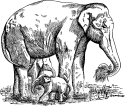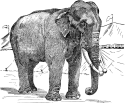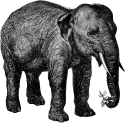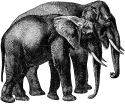|
Elephants are the largest living land animals
in the world today.
Elephant Classification:
Kingdom: Animalia
Phylum: Chordata
Class: Mammalia
Order: Proboscidea
Family: Elephantidae
Genus: Loxodonta
|
Other Names: Pachyderm,
Population: There are an estimated 450,000
- 700,000 African elephants and between 35,000
- 40,000 wild Asian elephants in the wild today.
Elephant in Foreign Languages:
Afrikaans: olifant
Albanian: elefant
Ancient Greek: elephas
Aramaic: pila’ / pilta’
Armenian: p'ig
Asturian: elefante
Azeri: fil
Basque: elefante
Belarusian: slon
Bengali: hati
Bosnian: slon / slonic
Breton: olifant / olifanted
Bulgarian: slon
Burmese: hsin
Catalan: elefant
Cherokee: kamam / kamama utana
Chinese: xiàng / dàxiàng
Croatian: slon / slonica
Czech: slon
Danish: elefant
Dutch: olifant
Esperanto: elefanto / virelefanto
elefantino
Estonian: elevant
Faroese: fílur
Finnish: norsu / elefantti
French: éléphant
Old French: olifan
Middle French: elephant
Friulian: elefant
Galician: elefante
Georgian: spilo
German: Elefant / Elefantin
Greek: eléfantas
Hebrew: pila/ pilta’ / pil
Hindi: hathi / hasti / gaj
Hungarian: elefánt
Icelandic: fíll
Indonesian: gajah
Irish: eilifint
Italian: elefante
Kongo: nzau
Korean: kokkiri
Lao: saang
Latin: elephantus / elephas
Latvian: zilonis
Lithuanian: dramblys
Lower Sorbian: elefant / slon
Macedonian: slon
Malay: gajah
Malayalam: aana
Maltese: iljunfant
Mongolian: zaan
Nahuatl: elefante
Navajo: bichi´i´h yee adilohii
Norwegian: elefant
Occitan: elefant
Ojibwe: jejiibajikii
Old English: elpend
Old Norse: fíll
Pali: hatthin / naga / gaja
Persian: fil / pil
Polish: slon / slonica
Portuguese: elefante / elefanta
Romani: woroslano / woroslanka
Romanian: elefant
Romansch: elefant
Russian: slon
Sami: elefánta
Samoan: 'elefane
Sanskrit: ibhas / gaja
Sardinian: elefante/elefanti
Scottish Gaelic: ailbhean
Roman: slon / slonica
Sicilian: liotru / lifanti
Slovenian: slon / slonica
Spanish: elefante
Swahili: ndovu / tembo
Swedish: elefant
Tagalog: elepante
Tamil: ya.Nai
Telugu: aenugu
Thai: chang
Turkish: fil
Turkmen: pil
Ukrainian: slon
Upper Sorbian: elefant / slon
Urdu: hathi / hasti / fil / pil
/ gaj
Uzbek: fil
Vietnamese: voi
Welsh: eliffant
West Frisian: oaljefant
|
|
|
Species: There are 3 species of elephants.
|
Elephant Species Include:
African Bush Elephant - Loxodonta
Africana Africana
African Forest Elephant - Loxodonta Cyclotis
Indian Elephant (aka Asian elephant) - Elephas
Maximus Indicus
|
Size: Female elephants stand 8 feet tall at
the shoulder and weigh up to 8,000 lbs. While male elephants
stand 10.5 feet tall at the shoulder and weigh, up to
15,000 lbs.
Habitat: African elephants are found in Africa,
while Asian elephants ar efound in India, Nepal, and
Southeast Asia.
Description: Elephants are large gray mammals,
with a thick skin. Elephants have big ears and a long
trunk muscular trunk. In fact an elephants trunk has
40,000 muscles in it, making it very flexible, agile
and sensitive. An elephant's trunk can be up to seven
feet long.
Diet: Elephants eat grass, leaves, twigs, bark,
fruit and seed pods. Elephants consume about 5% of their
body weight and drink 30-50 gallons of water per day.
|
Communication: Elephants vocalize a variety
of sounds from trumpeting calls to low rumbles.
|
Did You Know?
The calls elephants make can be heard
up to 5 miles away by other elephants.
|
|
Gestation: Elephants carry their young for 22
months. This is the longest gestation period for any
land mammal.
Birth: Elephants give birth to a single calf
at a time. A newborn elephant ways around 200-250 lbs
and is 26 to 42 inches tall at birth.
Sexually Mature: Elephants reach sexual maturity
between the ages of 17-20.
|
Life Span: Elephants typically live 50-70
years.
|
Did You Know?
An elephant’s skin is so sensitive
that it can feel a fly landing on it.
|
|
Social Structure: Elephants have a structured
social order. They are found in family groups. The group
is led by the oldest female in the herd. An elephants
herd consists of 8-100 members. Mature male elephants
abandon the heard between the ages of 12-15 and lead
solitary lives or live temporarily with other males.
|



















